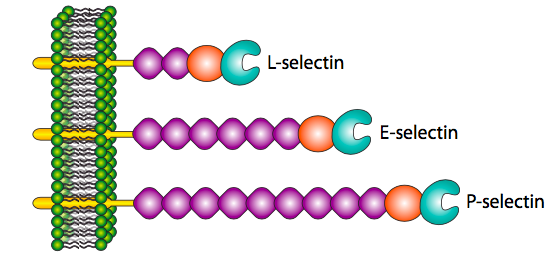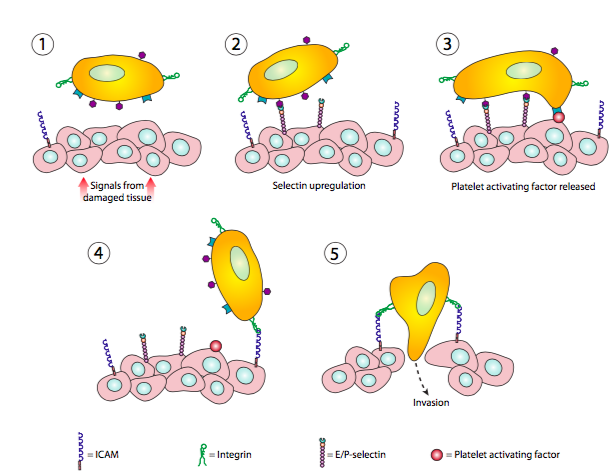13.13: Selectinas
- Page ID
- 53417
La última familia importante de moléculas de adhesión celular a discutir son las selectinas. Las selectinas se unen heterofílicamente a restos oligosacáridos en glicoproteínas. De hecho el nombre de la familia se basa en lectina, término genérico para las proteínas que se unen a los azúcares. Las selectinas, como las cadherinas y las moléculas de IgSF, son glicoproteínas modulares que pasan a través de la membrana una vez. Desde el extremo C hasta el extremo N, las selectinas están compuestas por un dominio citoplásmico relativamente corto, un solo dominio transmembrana, una serie de dominios CR (repetición consenso) o estructurales (desde 2 en L-selectina hasta 9 en P-selectina), un dominio similar al EGF (factor de crecimiento epidérmico) y un dominio similar a lectina. El dominio tipo lectina se une a un oligosacárido bastante específico compuesto por ácido siálico, galactosa, GlcNAc y fucosa, de los cuales el ácido siálico y la fucosa son los más importantes para el reconocimiento. La adhesión mediada por selectinas es un proceso dependiente de Ca 2+.

La L-selectina, que se encuentra en los leucocitos, fue la primera descubierta, en virtud de un interesante fenómeno llamado homing de linfocitos, en el que se extrajeron linfocitos de diversos ganglios linfáticos periféricos, se etiquetaron y luego se inyectaron de nuevo en el animal.
Estos linfocitos migrarían de nuevo a los tejidos de los que se derivaron sin tener en cuenta el sitio de reinyección. Las otras dos selectinas conocidas son E-selectina, que se expresa principalmente en células endoteliales, y P-selectina, que se expresa en plaquetas y células endoteliales. El ligando mejor caracterizado para las selectinas es PSGL-1, llamado creativamente ligando -1 de glicoproteína P-selectina. Tanto la E-selectina como la P-selectina son una parte importante de la respuesta inflamatoria, mediando la invasión de neutrófilos desde el torrente sanguíneo hacia el área de lesión (Figura\(\PageIndex{17}\)).


